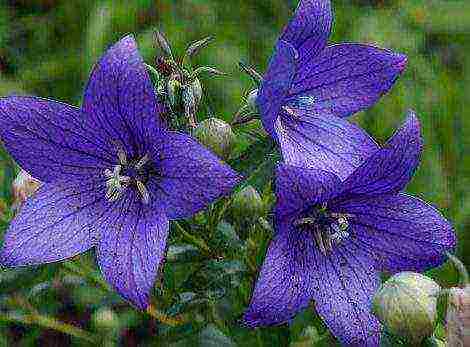Content
Garden and vegetable garden Vladimir Ravilov
|
2014-05-28 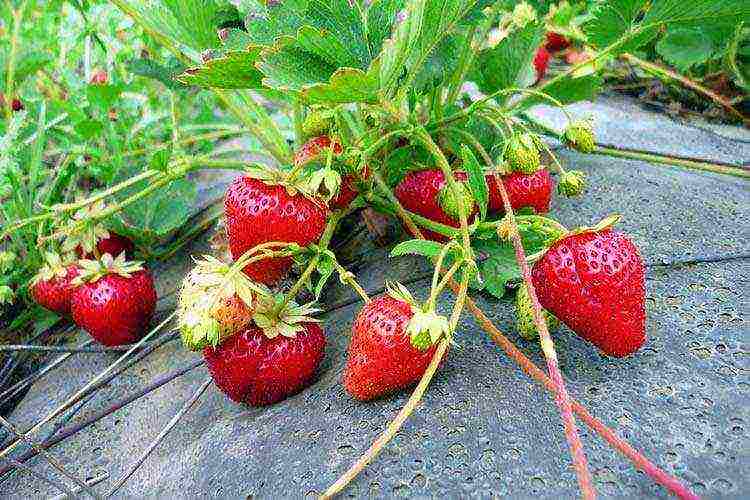 Strawberries on mulch
Strawberries on mulch
Growing strawberries on an industrial scale is not only fairly straightforward, but also cost effective. Due to their plasticity, strawberries can give high yields on soils of various origins and particle size distribution. However, the most valuable are soils of average granulometric composition with a reaction of the environment close to neutral.
The soil should be well filled with organic and mineral fertilizers, green mass of green manure or perennial grasses. Dry places, as well as damp with stagnant waters, and especially wetlands, are unsuitable for planting strawberries. Groundwater should not lie closer than 1 m from the soil surface.
The site is chosen leveled or with a gentle slope (no more than 5 ... 8 °). Low places where strawberries suffer from frost should be avoided.
 "A plot of land prepared for planting strawberries (USA)
"A plot of land prepared for planting strawberries (USA)
In the areas of the middle and southern zones, preference is given to the northern and northwestern slopes, in the more northern regions - to the southern and southwestern ones, where strawberries ripen 3 ... 5 days earlier. However, on the southern slope, there is more often the danger of freezing of plants due to the earlier melting of snow and more sharp fluctuations in temperatures in early spring.
There must be a source of water supply at the border of the site or nearby. In all zones around the plantation, protective tree edges are created, and within the massif - windbreaking lines. Protective plantings are planted in such a way as to create quarters with an area of 4 ... 10 hectares. The length of the blocks is 200 ... 500m, the width is 150 ... 250m. Every 100 m, the rows are divided by intra-quarter roads 3 ... 4 m wide.
Before creating protective plantings, strawberries are placed between the wings of corn, sunflower, sorghum, Jerusalem artichoke, etc. They are sown in 2 rows; the plants in the rows are thinned out, leaving a distance of 15 ... 20 cm between them. The wings are laid in 10 ... 15 m.
Crop rotations are introduced, under which the most favorable conditions for growing strawberries can be created. The best predecessors are pure fallow and green manure crops. It makes sense to grow crops in intermediate crop rotation fields.
Due to the spread of verticillary wilting, such crops as potatoes, tomatoes, cucumbers, cabbage (and other plants of the Cabbage family), fruit and berry plants are unsuitable as precursors.
Design of crop rotations for strawberries
When designing crop rotations, the economically viable life of the strawberry is determined. In one place, it provides high yields only for 3 ... 4 years. In subsequent years, winter hardiness decreases, strawberries are more affected by pests and diseases, the berries become smaller, and the yield decreases. Study the 1st 2-year life of the plantations.
In each farm, the crop rotation is compiled taking into account specific production and economic conditions. For example, the crop rotation for the Moscow region:
1 - winter crops for grain;
2 - oats for grain;
3 - annual herbs for sideration;
4 - busy or clean steam;
5 - young strawberries;
6 ... 9 - fruiting strawberries.
A 7-field crop rotation is recommended for the Central Black Earth zone:
1 - fresh strawberry;
2 ... 4 - fruiting strawberries;
5 - rye or oats for green fodder;
6 - vetch-oat mixture for green fodder;
7 - pure steam.
Soil preparation
Pre-planting soil preparation includes deep plowing (up to 40 cm) or plowing to a depth of 20 ... 25 cm with soil deepening and leveling the surface after plowing with a disc harrow in a traction with a harrow (or drag) in two directions. The last processing is carried out across the future rows of strawberries.
On chernozem soils, 30.40 tons of manure and Р60К60 are applied, on podzolic soils, the doses are increased to 80 ... 100 tons of organic fertilizers and Р20К150 per 1 ha. If necessary, lime-containing materials (3 ... 6 t / ha) are introduced in one of the crop rotation fields 1 ... 2 years before planting strawberries.
How to plant
In most areas, strawberries are planted in one line with a row spacing of 70 ... 90 cm and in a row of 15 ... 30 cm. In the future, the whiskers are shifted to the rows, the rosettes take root, and stripes 30 ... 40 cm wide are formed.
In the Central Black Earth region and more southern regions, during irrigation, a belt planting method is used with a distance between ribbons of 90 ... 100 cm, between rows in a ribbon of 30 ... 50 cm, and in rows from 15 ... 20 to 30 ... 40 cm. In the future, strips are formed 70 ... 80 cm wide, and for processing, leave aisles 60 ... 70 cm wide.
When growing strawberries with mulching with an opaque film, the plants are planted in a two-row scheme - (85 + 35) x 15 cm.
 Planting strawberry seedlings (USA)
Planting strawberry seedlings (USA)
Planting patterns also depend on the life of the bushes: the shorter it is, the denser the plants should be planted.
The best dates for planting strawberries are summer-autumn (August - early September) and early spring (until mid-May). Until recently, early autumn planting was considered the best. Usually at this time there is a lot of rainfall and the seedlings take root well.
The next year, a small crop is obtained from the plantation and strips are formed in accordance with the adopted planting scheme. In areas with a low and unstable snow cover, it is impossible to recommend an autumn planting of strawberries, since immature plants can freeze out.
Storing seedlings in refrigerators makes it possible to successfully plant strawberries in the middle lane until mid-June. Plants planted in spring have time to get stronger over the summer; the danger of their freezing in winter decreases. However, during spring planting, it is more often necessary to water young plantations.
On large industrial plantations, strawberries are planted with transplanters (SKN-6, SKN-6A, SKNB-4A). Some farms also use manual planting with preliminary marking and watering. Marking is carried out on a tractor "Belarus" in conjunction with cultivators KRN-4.2 or KRN-2.8. On the tractor, 2 ... 3 barrels with a capacity of 500 liters are hung from the sides. From the barrels through the hoses, water enters the openers and moistens the soil in the furrows. Watered at the rate of 1.5 ... 2 liters of water per 1 m row. Following this, the plants are manually planted.
Strawberry seedlings are planted so that after planting and compaction of the earth around the plant, the heart (apical bud) is at the level of the soil surface.
During transportation and planting, the seedlings are protected from drying out, the roots are dipped in a mash made of clay and mullein, the seedlings are placed in boxes or baskets and covered with damp burlap.
After landing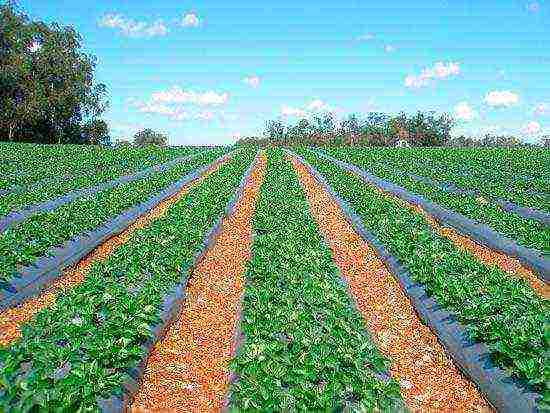 Strawberry plantation 5 weeks after planting
Strawberry plantation 5 weeks after planting
After planting, the aisles are loosened with cultivators. To protect plants from freezing, the rows are mulched before the soil freezes with peat, rotted manure or sawdust. For mechanization of work, a converted RPTM-2, OA spreader trailer is used. A special cover with stops placed behind the spreading shafts allows laying mulch along the rows in a strip about 30 cm wide with a peat consumption of 20 ... 25 t / ha. In early spring, this 2 ... 3 cm layer of peat is removed so as not to cause etiolation of the leaves.
Immediately after the soil freezes on the plantation, it is advisable to spread brushwood or place shields to retain snow.
During the growing season
During the growing season, the soil is cultivated in the aisles and rows, weeds are removed, the mustache is laid out and the sockets are sprinkled with earth.
Caring for a fruiting strawberry plantation includes loosening the soil, controlling weeds, pests and diseases, fertilizing, watering and other activities. As soon as the soil thaws, last year's curtain plants are raked, carried outside the plantation and burned. With mesh harrows, dry last year's strawberry leaves, which are the focus of infection, are raked and removed from the plantation.
 Strawberry Plantation (USA)
Strawberry Plantation (USA)
The soil in the aisles is loosened approximately every 10 ... 15 days, while the berries are still green. Before harvesting, it is recommended to carry out at least two treatments. After harvesting, the soil is treated with a FPU-4.2 cutter, which crushes and embeds mulching materials and weeds well.
In total, 6 ... 7 row spacing treatments are carried out during the season. However, it is not yet possible to completely exclude manual labor: it is necessary when weeding rows, especially in autumn. Simultaneously with the processing of the row spacings, the mustache is removed.
Top dressing
The introduction of 120 ... 150 tons of manure and complete mineral fertilization under the previous crops and before planting strawberries ensures proper nutrition for a number of years. In this case, fertilizers are applied only from the 2nd year after planting (ammonium nitrate - 0.15 t / ha, granular superphosphate - 0.25 ... 0.30, potassium chloride - 0.1 t / ha).
If it was not possible to prepare the soil well before planting, then the strawberry plantation should be fertilized from the first year after planting.
Organic fertilizers in the form of humus or peat-manure compost (15 ... 30 t / ha) are applied in the spring after the first loosening of the soil (in the form of mulch) or after harvesting. Mineral fertilizers (nitrogen, phosphorus and potassium - 40 ... 45 kg / ha) are applied in 2 terms - in the spring for the first loosening of strawberries and after harvesting.
How to water
If the soil moisture is below 75% HB, the plantation is watered. The best time for watering is before flowering, during the growth of the ovaries, before the berries ripen, after harvesting, in the fall (before the soil freezes) to increase the winter hardiness of plants.
In areas with a hot and dry climate, the number of irrigations is increased to 6 ... 8. The best ways to moisturize the soil is by sprinkling and furrow irrigation.
Harvest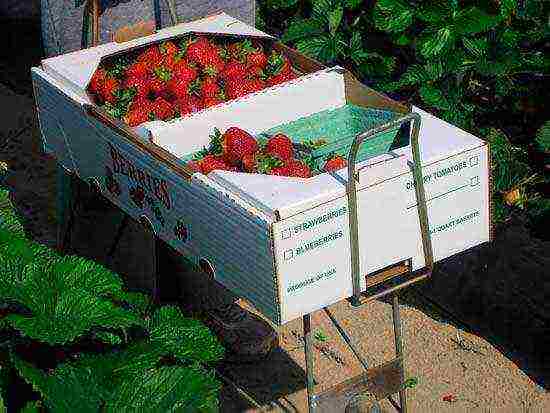 Strawberry Harvesting (USA)
Strawberry Harvesting (USA)
Harvesting is the most time consuming operation. The berries are harvested when fully ripe and slightly immature when transported over long distances. The containers for berries are popular popular baskets for 2.5 ... 3 kg; it is more convenient to use wooden trays with a capacity of 3 ... 3.5 kg.
In some farms, small-volume containers are used: boxes made of thick paper with a capacity of 0.5 ... 1 kg, plastic or wooden trays with a capacity of 3 kg and containers in which 6 trays with boxes are installed. The weight of the container with berries does not exceed 22 kg. When berries are sold in such containers, the time for loading and unloading operations is reduced, and the culture of serving the population is increased.
The harvesting period is extended by 1 ... 1.5 months, which is determined by a set of varieties. Depending on the weather and varietal characteristics, the berries are harvested in 1 ... 2 days. The strawberry yield is 6 ... 13 and even up to 30 t / ha.
About mulching
Film mulching of strawberries is used to obtain early and high yields. The best film for mulching is black opaque polyethylene film, it can last up to 4 years.
When mulching, the soil in the rows is not loosened, and in the first year of fruiting, 1 ... 2 weeding is carried out (near the holes where the plants are planted) and 3 ... 4 loosening of the rows.
A substitute for a polymer film is a cheap (5 ... 6 times cheaper than film) special thermohydrophobic paper, which decomposes after the end of the strawberry's life without clogging the soil.
After harvest
After picking berries, strawberry plants begin to form new horns, leaves, roots.The number of leaves on one plant, formed in autumn, correlates with the productivity of the plantation for the next year. Therefore, any agricultural technique that increases the number of leaves has a positive effect on the yield of strawberries.
The main of these methods is mowing old leaves in areas of 2 ... 3 years of fruiting, and in the case of severe weediness of the plantation and damage to leaves by pests and diseases - and in areas of the 1st year of fruiting.
Mowing is carried out with a unit - an MTZ-50 tractor coupled with a KIR-1.5 and a 2PTS-4 bogie. Leaves are mowed at a height of 5 cm from the soil surface (so as not to damage the horns) immediately after harvest. If the weather is dry, it is necessary to water, and in front of it - top dressing and harrowing.
So that the berries are not contaminated, 1 ... 2 weeks before harvesting, straw cutting is under the bushes (up to 4 ... 6 t / ha).
Year-round cultivation
Gardeners are increasingly attracted to the year-round cultivation of strawberries. At the same time, berries are obtained in open ground under film shelters (beginning - end of June), strawberries are grown according to the usual technology (2nd decade of June - end of July), berries are obtained in winter greenhouses (from January to May and from September to December).
Strawberry is the most popular berry, as it appears on our table first among horticultural crops. But summer passes quickly, and you always want berries, especially in winter. Breeders have developed varieties that grow and give high yields of delicious berries throughout the winter. How is the industrial cultivation of strawberries in the greenhouse carried out all year round? What varieties are suitable for this, read the article.
Growing strawberries
Depending on the production capacity and economic opportunities, different methods of growing strawberries are chosen. Dutch technology is very popular. How it works? Industrial cultivation of strawberries is carried out thanks to the continuous planting of seedlings throughout the year, regardless of the season. After a month and a half, when the harvest is over, the plants are thrown away, new ones are planted in their place.
In order for the fruiting of strawberries to be rapid, the bushes of plants receive special nutrition, which comes to them through pipelines. The drip method of fluid delivery is used.
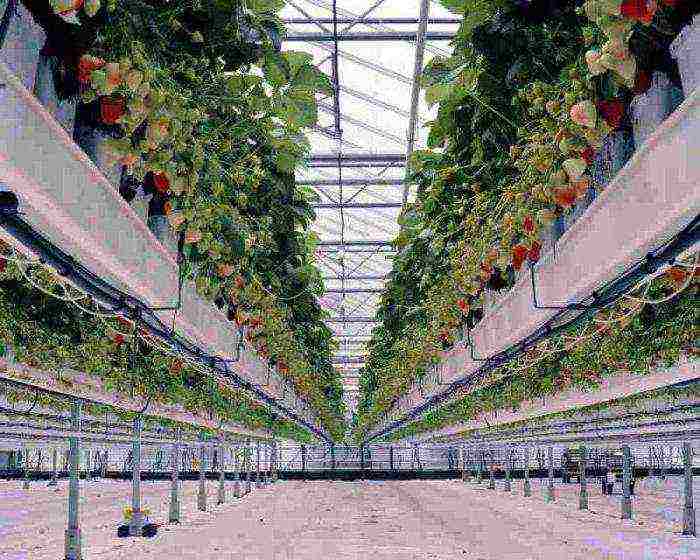
By following this technology, plants in the greenhouse can be placed vertically in pots or horizontally on racks. For comfortable growth, they need to provide decent content:
- Normal lighting. If it is not enough, additional light sources are installed. Approximate calculation: for six square meters, only one sixty watt light bulb is needed. If you increase the daylight hours to twelve to sixteen hours, the strawberries will bloom in ten days.
- Watering using a drip system. It should be done regularly and consistently.
- The optimum humidity in the greenhouse is no higher than eighty degrees. This is achieved through regular overhead watering. The procedures are stopped during the flowering period, since the ingress of water on the vegetative part of the plants leads to fungal diseases.
- If the greenhouse does not have a ventilation system, the room must be ventilated. Control over the level of carbon dioxide is carried out by special sensors.
- It is necessary to constantly maintain the temperature regime. Before flowering, eighteen - twenty-one degrees is enough, when the first flowers appear - twenty-eight.
- If necessary, artificial pollination of plants is carried out.
Planting strawberries in the greenhouse is carried out in the same way as in the open field. Planting material is seedlings obtained by rooting a whisker and seedlings grown from seeds. Industrial cultivation of strawberries is carried out with seedlings purchased from specialized stores or nurseries.
Strawberry varieties for industrial cultivation
There are many varieties and hybrids of strawberries.But for industrial cultivation in the greenhouse conditions of the Far East, Siberia and the Urals, remontant varieties are better suited. There is no need to create artificial pollination for them, since these are self-pollinated varieties. Repair strawberries ripen early, which ensures a good harvest even with thickened bushes.
This strawberry belongs to a group of plants with neutral daylight hours, so there is no need to install additional lighting in the greenhouse. There are many repaired varieties, some of them are presented below.
Elsanta
This strawberry variety is popular and is widely grown outdoors and in greenhouses. The value lies in the high quality of berries, attractive appearance. The fruits are well transported, stored for a long time without compromising quality, even at room temperature.

This is a Dutch dessert variety. The berries are large and bright red with a shiny surface. They have a wide cone shape and amazing taste. The disadvantage of the variety is susceptibility to fungal diseases and low frost resistance. In order for the plants to survive until spring, they need to be covered for the winter.
Honey
This strawberry variety has a high yield. If you plan to grow strawberries on an industrial scale, Honey is ideal for greenhouses and open ground, as it has good transportability. The berries of this variety are large, with a dense skin and dark red color, they have a spicy taste with sourness and a glossy sheen on the surface. Harvested when the berries are fully ripe.
This strawberry variety is resistant to disease. He is not afraid of temperature extremes, heavy rains and frosts, if grown in the open air. Strawberries grow even in soils with excessive calcium content.
Albion
Growing strawberries in industrial greenhouses for business is recommended to start with this remontant variety that gardeners love. After all, this strawberry has the longest fruiting time. The berries have excellent taste and excellent presentation. They are transported without loss of quality.
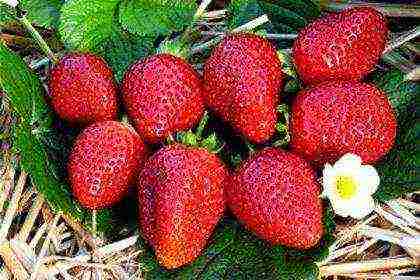
The large, elongated berries are attractively shaped like a cone. They are used fresh and processed: they prepare confitures, jams, preserves. Strawberries are resistant to late blight, verticillosis and other diseases. It endures unfavorable weather conditions.
Portola
This American-made remontant strawberry is new. But he managed to recommend himself in the best way, especially for those who plan to start industrial cultivation of strawberries in a greenhouse all year round. Portola is a continuation of the reputable variety Albion. But the new variety has a yield higher than its predecessor by thirty percent.
The berries are very large, heavy, their weight reaches thirty grams or more. They are distinguished by their expressive shape, in the form of a wide cone. The pulp is firm, without crunch. Very pleasant, harmonious taste.

The disadvantage of the variety is its weak resistance against diseases such as brown spot. Therefore, preventive treatments with fungicides, such as Quadris, should be carried out regularly.
Monterey
This is a remontant strawberry from the state of California. It is a continuation of Albion, only its yield is twenty-five percent higher. The industrial cultivation of Monterey strawberries is a good choice for a successful business. Especially for the autumn-winter and spring seasons. The berries are large in size, the pulp is juicy and sweet in taste.
Industrial greenhouses
In order to get tasty and healthy berries for a long time, they are grown in greenhouses, which are of two types:
- Seasonal. They are more popular, since their construction requires a small investment. In such greenhouses, cultivated plants of vegetable gardens and orchards are grown from March to November, that is, until the time when heating is required.
- Year-round.The construction of such greenhouses requires large investments. This is due to the construction of premises for equipment. Such buildings are highly profitable, as they grow vegetables and fruits all year round.
Industrial scale strawberry greenhouses vary in many other ways. So, glass cover is used for seasonal greenhouses, since its installation requires a strong frame.

Polycarbonate has become very popular as a covering material. It is easy to install, has great strength, high thermal insulation properties and good light transmission. It tolerates temperature extremes and is easily transported without being deformed.
Greenhouse beds are arranged in the ground, on racks (horizontally) or in hanging bags (vertically). The frame of greenhouses can be made of wood, metal or polymer. The choice of a greenhouse depends primarily on financial capabilities and production areas.
Strawberries in the open field
Industrial cultivation of strawberries in the open field is simple and economical. This is achieved due to the fact that strawberries grow on soils with different granulometric composition.
In order for the yield to be high, the soil is filled with fertilizers, green manure and perennial grasses. Dry areas, damp with a large amount of stagnant water and swampy are unsuitable for the growth of strawberries. Surface occurrence of groundwater is undesirable.

Industrial cultivation of strawberries is carried out on flat areas or gentle slopes. If you define low places for it, it may suffer from frost. There should be a natural or artificial reservoir near the site.
Ridges with strawberries are surrounded by tree plantations on all sides. They are planted in blocks of 4x10 hectares, which are separated by internal roads three to four meters wide. Rows for planting strawberries must be at least one hundred meters wide.
Crop rotations
The industrial cultivation of strawberries provides for such an agrotechnical measure as the design of crop rotations. Growing in one place, strawberries give high yields for three to four years. Then it weakly resists frost, is more often affected by diseases, its berries become smaller. As a result, the yield decreases.
The crop rotation of each farm is compiled taking into account production conditions and economic opportunities. An example of a seven-pole crop rotation for the Chernozem regions of Russia:
- Strawberries are planted in the first field.
- On the second, third, fourth - a fruiting strawberry grows, it gives good yields.
- On the fifth site, where strawberries grew, oats or rye are planted to prepare green mass for livestock feed.
- In the sixth section, the vetch-oat mixture is planted, from which feed for livestock is prepared.
- The seventh section is left under steam, nothing is planted on it.
How to prepare the soil?
Before planting strawberries, in open ground or a greenhouse, the soil is plowed to a depth of forty centimeters or slightly less. Then its surface is leveled by the harrow, first in one direction, then in the other, and at the end of the process - across the rows.
The next step is to apply manure. Per square meter of chernozem soil - thirty to forty tons, podzolic - eighty - one hundred for the same area. Approximately a couple of years before the planned planting of strawberries in a new place, one field participating in the crop rotation is selected, and three to six tons of lime fertilizers are applied to its soil per hectare.
Planting strawberries
The technology of industrial cultivation of strawberries can be different, but more often they use a single-row planting method. Plants are planted in rows, the distance between them is seventy to ninety centimeters, and between the seedlings - fifteen to thirty.

If strawberries are grown using mulch film (outdoors), the plants are planted in two rows. The distance between the rows is eighty-five centimeters. But in one row, strawberries are planted with two ribbons, the distance between them is thirty-five centimeters, and between the plants in each ribbon is fifteen.
The planting pattern is directly related to the period of use of the strawberry bushes. If the crop in one field will not grow for long, the plants should be planted tightly, as with the Dutch technology in a greenhouse.
The optimal timing for planting in open ground is considered to be late summer - early autumn and early spring. But it is still better to plant strawberries in early autumn. This time is characterized by the fall of numerous precipitations, which is a favorable condition for good survival of seedlings. For areas where there is little snow, it is not recommended to plant strawberries in the fall, as the plants do not have time to get stronger and may freeze out.
Strawberries are planted on an industrial scale on large plantations with special machines, which are called transplanters (brands of aggregates - SKN-6, SKNB-4A and others). If it is not possible to use machine labor, manual labor is used. But first, watering is carried out and marking is done with a Belarus tractor with a cultivator attached to it.
These terms do not apply to strawberries growing in a greenhouse. So, following Dutch technology, seedlings are planted every one and a half months, regardless of the season.

- Growing strawberries outdoors
- The disadvantages of open ground are obvious:
- Video about a successful open field strawberry farm:
- Hydroponic strawberries
- Trukars - vertical cultivation of strawberries
- Growing strawberries in bags according to Dutch technology
- Step-by-step opening plan
- How much can you earn
- How much money is needed to start a business
- Which equipment to choose
- What OKVED to indicate when registering a business
- What documents are needed to open a business
- conclusions
Strawberries are a popular berry that is loved not only in our country, but all over the world. Strawberries are consumed both fresh and used in processing, to obtain jam, jam, juices, etc. With the appearance of the first harvests in the spring season, the berry is literally sold out. And sometimes it doesn't matter what the price tag is. And a kilogram of early strawberries in large cities costs at least 250 rubles ...
You can start your mini-business on growing strawberries even from a summer cottage. For the sale of the first batches of berries, no documents are needed, since the products are sold from a personal subsidiary farm. Registration of individual entrepreneurs, tax deductions, all this later, when industrial scale appears. At first, the sale of berries can be carried out through fruit shops and kiosks, as well as handing over berries in small wholesale to dealers.
Do you want to learn more about business and earn stable income? We offer you a catalog of real estate courses. By choosing the method you are interested in, you can get a good income by doing an understandable thing.
Growing strawberries outdoors
Growing strawberries outdoors is the most common method. There are a number of objective reasons for this:
- Low investment. No buildings in the form of greenhouses and hydroponic installations are required. You can start at least with your own garden, and then, as necessary, either rent a plot or buy it out. The main investments: fertilizers, planting material and drip irrigation (not counting the land plot).
- The technology is simple and straightforward. A little literature - and you can get a good harvest.
- Strawberries grown outdoors are juicy, sweeter and more natural. It is much easier to sell such a product.
In the open field, strawberries are planted in rows, at a distance of 35 - 40 cm from each other. The soil must be covered with spunbond-based agrofibre. This material protects the plant from direct sunlight, while retaining moisture, allowing air to pass through and accumulating heat.
The most common varieties for open ground: Gigantella, Elizabeth II, Albion, Honey. The fruits of these varieties are large and appetizing. So, the fruits of the Gigantella variety grow up to 100 grams. Only 10 berries - we get a kilogram of marketable strawberries.
The disadvantages of open ground are obvious:
- Seasonality. Depending on the climatic conditions of the region, strawberries can only be grown between May and September.
- Dependence on weather conditions. Drought, frost, etc., and you can lose almost the entire crop.
- Diseases, pests, weeds, which are present in abundance in the open field, will not give rest to the farmer.
- Harvesting - you have to pick the berries, literally crawling along the ground, which is extremely inconvenient. From here we get higher labor costs during the harvest season.
For all its pros and cons, outdoor cultivation is the surest way to start a strawberry business. First, it is cheaper and therefore less risky. Secondly, you do not need to have any serious knowledge to plant a field and harvest the first crop.
Finally, this will allow you to try to sell the berry. And sales in this business, as practice shows, is the most difficult stage. Having learned how to sell, you can think about how to increase production volumes. On this score, there are other, more expensive, but more efficient ways to grow strawberries.
Video about a successful open field strawberry farm:
Hydroponic strawberries
Hydroponics is a very popular indoor growing method. So, in Israel, more than 80% of farms use hydroponics. This method involves planting plants in a thin layer of organic substrate (peat, for example), laid on a net and placed in a tray with a nutrient solution. In simple terms, in hydroponics, the plant does not feed from the soil, but from a mineral solution, the composition of which is formed depending on the type of plant.
Strawberries are also actively grown hydroponically, although there are few such farms in our country. What are the benefits of hydroponics:
- The plant always gets the right amount of nutrients, much more than from solid soil. Hence the faster growth and faster harvest.
- There is no need for daily watering.
- Pests and diseases that are characteristic of growing in soil (bear, fungal diseases, nematodes) are completely absent.
- There is no need to purchase soil for strawberry transplanting and to spend on its delivery.
- It is much easier to replant the plant without damaging the roots.
- The output of the berry is ecologically clean, since no pesticides and pesticides are used in the cultivation process.
Particularly successful farmers manage to get up to 45 kg of strawberries from 1 sq. m., or 450 tons per hectare!
The hydroponic method is extremely popular with homeowners who grow berries as a hobby. People in this way plant strawberries not only in greenhouses, but also on window sills. And the fresh berry, with the choice of the appropriate varieties, grows all year round.
Complete hydroponic plants and systems can be purchased from specialized companies. Also, a hydroponic plant can be designed with your own hands, since there are many videos on this score on the Internet. For example, this:
As a basis for the installation, you can use ordinary plastic containers placed on racks.
If we talk about large planting areas, then the obvious disadvantages of the system can be attributed to the high cost of structures and high energy costs, because a continuous supply of oxygen to the solution is required for plant growth.Moreover, if an entrepreneur decides to grow strawberries in this way on an industrial scale, the construction of greenhouses will be required, which makes the project very expensive.
Skidding costs. A hydroponic plant for 30 seats will cost about 10,000 rubles, for 3,000 bushes - 1,000,000 rubles. In terms of area, so many installations will occupy about 50 square meters. m. A fully equipped greenhouse of this size will cost about 150,000 rubles. In total, the total cost of the project exceeds a million, excluding the costs of planting material and substrate.
Trukars - vertical cultivation of strawberries
An interesting device called "Trukar" was invented by Alexander Naseichuk from the Leningrad region. Trukar is a pipe with pockets, installed vertically. A strawberry bush is sown in each pocket, which is connected to a drip irrigation system. What are the advantages of trukar. First, the greenhouse area is significantly saved (by about 300%). One trukar occupies only 0.5 sq. m. and accommodates 90 strawberry bushes. That is only 1 sq. m. we can place 180 strawberry bushes, thereby increasing the profitability of the entire greenhouse. Secondly, the trukar is very convenient in terms of planting plants and their subsequent care.
For more information on growing strawberries in trukars, see the following video:
During the season (2 - 2.5 months), up to 12 kg of strawberries are harvested from one trukar. Accordingly, from 500 trukars (500 sq. M.) 6 tons of strawberries can be obtained. In monetary terms, this is approximately 1.2 million rubles. proceeds, if you sell strawberries on average at 200 rubles / kg. This is if we take into account the usual varieties. With remontant varieties, the yield and income, respectively, can be slightly higher.
Growing strawberries in bags according to Dutch technology
A variation of the vertical method is the cultivation of strawberries in plastic bags using the so-called Dutch technology. The essence of this technology is that the seedlings are planted in a certain interval, after 2 - 3 months. This allows you to harvest constantly, without using remontant varieties for this.
In order for strawberries to begin to bear fruit, regardless of the time of year, it must be preserved, that is, sent into hibernation, as it happens in natural conditions. To do this, well-developed strawberry bushes are cut in the fall and stored in a refrigerated place. An ordinary refrigerator is suitable for these purposes. The result is a seedling called "Frigo" (frigo). Such seedlings can be "woken up" at any time by planting them indoors in a greenhouse. It doesn't matter when you do it, in January or May. The main thing is that the greenhouse is ready for planting. A couple of months after planting, strawberries will bring their first harvest.

The best varieties for Dutch technology are Elsanta, Darselect, Maria, Sonata, Mrak, Polka, Tristar and, of course, Albion (the most popular greenhouse strawberry variety).
Strawberries are planted in bags welded from white plastic wrap. The bag is 2 meters long and 16 cm in diameter. The bag is filled with a substrate including soil and fertilizer. Further in the bag, in a checkerboard pattern, holes are made of 7 cm in four rows, at a distance of 25 cm from each other. Then the bags are hung on special supports, 2-3 bags per square meter. You can do it a little differently by placing the bags horizontally on ordinary shelving. In this way, you can make several tiers. Plant nutrition is carried out using droppers, which are supplied in three parts of the bag every 50 cm. Strawberries are pollinated by hand, using a soft brush or by means of a fan.
Step-by-step opening plan
Having a certain amount of money to start, you need to decide which method of growing strawberries is right for you. Based on this, choose:
· Place (or room) for planting strawberries;
· Equipment for growing berries;
· Planting material - the variety that is most beneficial for this method of cultivation;
Product sales plan
How much can you earn
When grown in the open field, in the 2nd year, 10 acres provide both seedlings and enough berries - 700-800 kg. At the same time, all costs of the first year are covered: planting material, drip irrigation system, film or agrofibre. You can expand the landing area. But the third year already gives a clean and good income. About 5 thousand strawberry bushes guarantee up to 2 tons of excellent berries.
The profitability of growing strawberries in a greenhouse is over 100% and the payback is usually predictable in the first season. But, the initial investment in the organization and equipment of the greenhouse economy is 30-50% higher than in agricultural production in the open field. When grown in the Dutch way (in bags), up to 30 kg can be obtained from one square meter. garden strawberries. When selling berries in the summer, with an average price of 70 rubles. per kilogram, from one square meter you can earn more than 2 thousand rubles. And in the cold season, the price of a "vitamin product" will on average be about 200 rubles / kilo, the benefit, respectively, up to 6 thousand rubles. With a yield of berries from 50 square meters and taking into account costs, the profit will be under 300 thousand rubles.
How much money is needed to start a business
On average, it will take 1300-1450 thousand rubles to build a greenhouse with a plot for planting 1 hectare. To equip a 1 meter square room for the production of berries in bags, you will need about 300 rubles (including planting material).
If you have problems with starting capital, we offer the opportunity to earn at least some of the money. For this purpose, a set of 50 methods offered by us is suitable. From there, you can choose starting options without investment.
Which equipment to choose
Growing equipment:
· In open ground - drip irrigation (pipes, fittings and filters, drip tape), mulching film or agrofibre;
· By the Dutch method - a room (barn, garage, etc.), polyethylene bags 200-220 cm long, 15-16 cm in diameter. For each bag there are 3 irrigation pipes and a mixture of peat and perlite;
· For hydroponics - trays, pumps, tubes and nutrient substrate;
· For trukarny method - a pipe with pockets, substrate, irrigation system.
What OKVED to indicate when registering a business
Code 01 is responsible for agricultural production of strawberries. Agriculture, hunting services in these sectors, namely 01.1. Plant growing. And its clarifying subparagraph 01.13.21. Growing fruit and berry crops.
What documents are needed to open a business
Registration of a peasant farm (PFH) is necessary when there is a large enough work and processing area (more than 1 hectare). Otherwise, it is allowed to maintain a subsidiary farm on a personal backyard without any taxes.
conclusions
We have looked at 4 of the most famous ways to grow strawberries on an "industrial scale". Each option has its own advantages and disadvantages and requires careful study before use. Which method is better to choose is up to you, because a lot depends not only on the growing conditions, but also on the available financial resources for the implementation of the project.
(
estimates, average:
out of 5)
Loading…
Related business ideas:
Good afternoon, I am interested in the industrial cultivation of strawberries. Please tell us how to organize this process and what is needed for this. Thanks in advance for your reply.
Hello! The industrial cultivation of strawberries is a very profitable business. This plant is quite unpretentious, so it bears fruit on all types of soil.
- For higher yields, organic and mineral fertilizers, green mass of green manure must be added to the soil.
- Strawberries will not grow in dry and wetlands.
- The land plot must be flat or with a slight gentle slope.
- It is worth worrying in advance about the availability of a water supply source near the plantation.
- Protective plantings should be placed around and inside the site: corn, Jerusalem artichoke, sunflower, sorghum.
- In one place, strawberries effectively bear fruit for 3-4 years. Then the plants need to be replanted, and the field must be sown with grain or green manure crops.
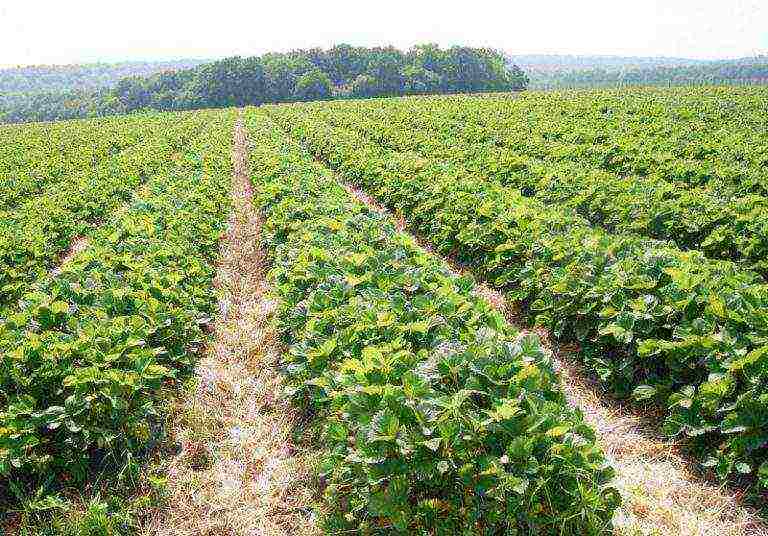
Soil preparation consists of deep plowing (up to 40 cm) and manure application. If possible, one of the crop rotation sites is dug up with quicklime (3-6 t / ha) 1-2 years before planting strawberries.
Saplings are planted in August-September or March-April.
When planting in autumn, there is a risk of freezing of young plants, so they must be covered with sawdust and brushwood for the winter. For spring planting, regular watering is required. Outlet layouts may vary. Most often, a tape planting method with mulching with a black film is used. Strawberry seedlings are placed in two rows. The apical bud should be at the level of the ground surface.

During the growing season, the beds are regularly weeded, the soil is loosened, the mustache is laid out in the right direction and the young rosettes are sprinkled with soil. Along with this, strawberries are regularly watered, fertilized, and protected from pests and diseases.
Remove all old leaves early in the season. Watering is most effective before flowering, during the ovary, before fruit ripening, after harvesting, in the middle of autumn to improve the winter hardiness of plants. Ripe berries are collected in small containers, which ensures their presentation and quick sale.
Rate the article:
(0 votes, average: 0 out of 5)
